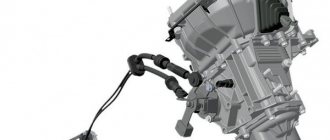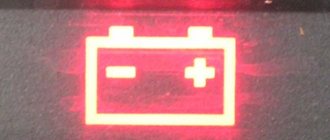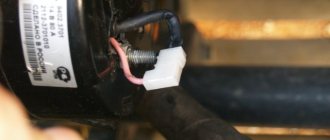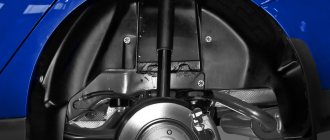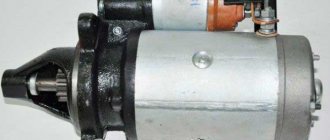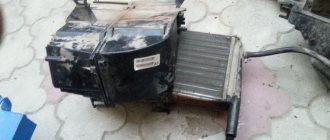Characteristics of the standard Kalina battery
Since there are many companies in our country specializing in the production of car batteries, it would be strange if AvtoVAZ employees opted for a battery of a foreign brand. So from the very beginning, Akom brand batteries were installed on the Lada Kalina.
They cannot be called outstanding. Although they are adapted to the harsh Russian conditions, the average service life of these products is short by modern standards, about 3–4 years. This is due both to the imperfection of the technological process and to unsuitable operating conditions - domestic motorists are not always careful and disciplined.
As for the main characteristics, the polarity of standard batteries is straight, typical for cars aimed at the Asian market. This factor must be taken into account when purchasing a new power source.
The nominal capacity of Akom batteries for Kalina is 55 A*hour at 425 A starting current. Note that these are minimum characteristics, below which it is simply not advisable to buy a battery - it will not cope with its responsibilities.
The size of the battery for the Lada Kalina is 24.2x19.0x17.5 cm, but here you need to take into account that these are the maximum allowable dimensions - larger batteries simply will not fit on the landing platform. Such a battery costs from 3,000 rubles - a small amount, but most owners prefer to install more expensive products that have a longer service life.
What does a “state employee” like?
The Kalinovaya Lada is often called a budget car option. And this is largely true. But this aspect does not mean that this “simple” car loves “cheap” spare parts, components and mechanisms.
When deciding on choosing a battery for a viburnum, take your time. And especially don’t save money. Even “state employees” don’t like “penny” ingredients for themselves and their loved ones/
By the way, here it is necessary to say about the inconsistency of a number of individual recommendations that are present on some automobile forums. Here you can often see advice like this: “Viburnum can eat everything. More precisely, cheap spare parts and components will suit it. Don’t worry too much about it.”
How can you comment on these statements? Sheer nonsense! Car enthusiasts who recommend this adhere to the following principle: I’ll drive my car for a year or two, and then, lo and behold, I’ll buy myself a new one. But no one thinks about how the car will feel after negligent care and what problems the new owner will have to face.
Our advice to you: do not listen to unprofessional recommendations. And provide quality care for your car. And then it will last a long time.
Carefully study the topic of which battery is best for this AvtoVAZ brainchild. This will help you choose a decent option for the Lada Kalina.
So what does this car like? When choosing a battery, you should in any case follow the recommendations of the manufacturer. Ignoring the “factory advice” threatens a serious blow to the well-being of your Lada Kalina, its technical capabilities and “longevity”. This is the main rule, following which you can choose a truly high-quality battery.
Under what conditions should the battery be changed?
Average battery life is a relative concept and depends on many factors. Therefore, you should not rely on this indicator: there are very specific and obvious criteria by which one can judge that the battery needs to be changed. Otherwise, in the near future you will have to face difficulties when starting the engine cold.
So, let’s list the main signs that eloquently speak of the imminent “death” of the battery:
- the engine starts is problematic not only in winter, but also in the warm season;
- a light on the instrument panel is often or constantly lit, indicating that the battery is undercharged;
- after a trip over a distance of more than 15 km, the battery charge level is less than nominal - if the generator is working, this indicates the impossibility of fully charging the battery;
- if after charging using a charger the electrolyte density does not exceed 1.25 g/cm3. If adjustment by adding electrolyte does not help, the battery should be replaced;
- the liquid has acquired a dark tint, this indicates shedding of the plates - a phenomenon that requires urgent replacement of the battery.
If you turn on the radio for about 60–80 minutes while the engine is not running, and after that the engine does not start or starts with great difficulty, this means that the battery no longer holds a charge, and it’s time to invest in a new battery.
How to choose a new battery for Lada Kalina
When choosing a battery to replace an old one, it is recommended to follow the recommendations of the car manufacturer, but they are not always optimal. Let's look at the most important criteria that should be followed when visiting a car dealership.
Brand
Of course, the popularity of a brand can be considered an important measure of quality for any product. In our case, this is all the more justified: although there are several domestic brands whose products can be called competitive, in general, Russian batteries are still noticeably inferior to foreign ones (except for Chinese batteries).
And yet the brand is far from the main selection criterion. The main thing is that the characteristics match.
Date of manufacture
The shelf life of batteries, unlike food products, is not indicated, but the length of time a battery is stored in a warehouse is an important indicator, especially for conventional lead-acid batteries. It is best to buy products that were manufactured less than 4–5 months ago, and it is better not to look at batteries that are more than a year old. And the basic rule - be sure to check the purchase with a load plug, so as not to become the owner of a half-dead battery.
Capacity
This is one of the main criteria on the basis of which you should decide which battery to choose for your Lada Kalina. In our case, the lower marker is the capacity of the standard battery, or 55 A*hour. The upper limit is 65 A*hour; a standard generator will not support more powerful batteries, and the dimensions may not be suitable.
Starting current
This parameter is just as critical as capacity, since it determines how easy the engine will be to start in cold weather. In severe frosts, the battery can be discharged by 30–40% overnight, so a product with insufficient starting current will not be able to cope with the morning start of the power unit. Here the selection criteria are similar to the previous point: you need to install a battery whose PC rating is no less than that of a standard battery (425 A). The upper limit is limited only by the dimensions of the power source. Well, and the cost, of course.
Polarity
On most foreign cars presented on the domestic market, the polarity of standard batteries is reversed, corresponding to the European format. In Kalina it is straight, so it is important not to confuse this indicator when choosing. You are unlikely to be able to install a battery on your car if the terminals are located in the wrong sequence - most likely, you simply do not have enough cable length. However, some craftsmen manage to remake the seat to get around this obstacle.
Load fork test
When purchasing an expensive battery, such a procedure is not only advisable, but mandatory. As a rule, sellers do not refuse this opportunity, and many themselves check the charge using a load plug. Its essence is to measure the voltage at the battery terminals after applying voltage to the load for 10 seconds. If the difference turns out to be more than 9 volts, it is better not to take such a battery.
Guarantee
This parameter should not be underestimated. Although largely marketing in nature, to a certain extent the length of the warranty is correlated with the life of the battery. For example, most domestic products and many foreign ones come with a standard 24 month warranty. This is neither more nor less. Batteries are available with a 4-year warranty. They are expensive, but you can rest assured that they will last, on average, twice the warranty period. But the 12-month warranty is a reason to think about whether it is worth purchasing such a product.
Battery Type
This is the most controversial criterion. Classic antimony batteries are still popular, although they are noticeably inferior to calcium batteries in most respects. The latter have a significant drawback - fear of deep discharge. Hybrid batteries combine the advantages of calcium and antimony power sources, but they also share some disadvantages. In short, these are the most versatile batteries.
Batteries made using AGM technology, as well as gel varieties, are still expensive and have disadvantages that do not justify their purchase.
Selection by capacity and starting current power
Since the original battery on the Grant is installed with a capacity of 55 Ah, you should not violate these requirements. It won't be any better for two reasons:
- Firstly, the battery will not be fully charged, which may affect its service life
- Secondly, the generator will constantly work at maximum to try to charge the battery, resulting in excessive heating of its parts and even failure of some of them.
From personal experience of using a battery with a capacity of 65 Ah, I can say that in half a year I had to change 3 diode bridges. But as soon as I changed the battery to a 55, such problems no longer arose.
So, of those considered with a capacity of 55 Ampere hour, I liked Bocsh Silver, the price of which was 3,450 rubles. Silver class are batteries that can confidently start the engine even at the lowest temperatures. So, if the winters in your region are very harsh, then I recommend taking a closer look at these models.
Regarding the starting current, I can say the following: on my native AKOM this value was only 425 Amperes, which was clearly not enough in severe frosts. But on the Bosch I chose, the starting current was 530 Amperes. Agree that the difference is simply huge. After purchase, I tried to start it at -30 degrees, and there couldn’t be any hint of “electrolyte freezing.”
In general, I was pleased with the choice, and I hope that the battery will serve its 5 years on my Grant. After all, such a period is far from the limit for a German manufacturer!
At the beginning of October we visited a completely new enterprise producing batteries. In addition, it is going to become one of the suppliers of its products to JSC AVTOVAZ and its joint
with General Motors, an enterprise, and this is doubly interesting.
It all started with the fact that a certain proactive group of managers thought that, despite the abundance of factories producing batteries in the country, the Volzhsky Automobile Plant was forced to purchase batteries abroad. The main supplies are currently being made from Ukraine, which, against the backdrop of the latest increase in import duties on Russian cars, does not look entirely appropriate, although in terms of price-quality ratio, Ista batteries are quite acceptable.
And then the Tudor company, part of the Exide group and controlling 45% of the battery market in Europe, arrived in time with a proposal to build a modern production facility on Russian territory. In general, the interests, as they say, coincided. It remained to find suitable areas near VAZ, and they soon turned up in the city of Zhigulevsk, which is located on the opposite bank of the Volga. The local Energotekhmash plant has not been very spoiled with orders recently.
For the construction of the plant, 11,200 square meters were cleared of old equipment. m of production buildings, and also brought in a new one - 2001, which indicates the use of truly new technologies. Which ones exactly?
If we talk about the batteries themselves, they use calcium-calcium (Ca-Ca) technology. This means that the composition of the active mass of positive and negative plates includes the above-mentioned element instead of the usual antimony. The plates themselves are also unusual. They are made mechanically from lead tape, which is simply cut, holes are punched in the plates, and then their walls are also stretched.
New Lada: Learning to choose and change running lights on a Grant
Thus, harmful lead casting is eliminated from the process, the plates are smaller and lighter than usual, and the active mass is better retained on the inverted jumpers. In addition, one of the plates (positive or negative) is placed in a special bag that prevents the active mass from shedding and short-circuiting the plates to each other.
Now at AKOM they enclose a negative plate in a package, which somewhat reduces the starter current. but increases durability. All these methods make the battery virtually maintenance-free. increase its reliability and stability of technical characteristics, and the active mass used increases the capacity with the same dimensions.
Now about the technologies used in the production of rechargeable batteries. This is what we saw when we visited the plant.
The first is a wet floor made of a special moisture-resistant material, constantly watered. This is done so that people do not breathe dust that settles on it from the air, including lead. The air itself is purified by a modern Swedish closed-cycle system. The water also does not disappear anywhere, but, after undergoing purification and demineralization in a special apparatus, it is used to prepare the electrolyte.
Second: very few people are involved in the production process. Most operations are automated. Here, for example, is a machine for producing cases. All that is required is to pour granulated polypropylene into it and add dye, and then just have time to store the finished boxes. By the way, the material for the cases is supplied from Korea, because domestic manufacturers set such prices that it turned out to be economically unprofitable to buy from them.
Next, the cases go to two assembly lines, where they are filled with packages of plates (currently supplied by Tudor). At each stage of assembly, be it welding plates, installing jumpers, top cover, etc., there is an automatic check for short circuits, conductivity and tightness of the housing.
If a defect suddenly occurs, the smart machine itself will remove such a battery from the line. Next, the finished batteries are transported along the conveyor to the electrolyte filling area. It, like the process of preparing electrolyte, also does not require the constant presence of a person, and only for charging a person is needed to put on and remove the terminals of the charger in time.
After charging, some of the batteries go to a stand where the computer subjects them to comprehensive testing, and if it doesn’t like something, it will reject the battery and issue a printout of all the parameters upon request. Such strict control at all stages of production allows us to eliminate the release of low-quality products.
The young enterprise has truly ambitious plans. Thus, at the first stage of development, which should be completed in 2003, it is planned to invest 3.3 million dollars in the plant, and soon the enterprise should reach a design capacity of one million batteries per year, or 4120 per day (at the time of our visit it was already more than 2000 batteries were produced per day).
New Lada: What are the reviews about AMT 2.0 on the Lada Granta - the opinion of experts and owners » Lada.Online
At the second stage, it is planned to invest another 9 million dollars to create an integrated production, in which almost all components will be produced at the plant. The third stage involves the introduction of technology for recycling used batteries. Moreover, on the territory of Russia it is planned to build several plants for their disposal, processing and remelting of lead. And that’s not all.
Thus, this project is beneficial to everyone: foreign companies receiving their profits, domestic enterprises loading their idle space, consumers purchasing world-class products, and, of course, the state, which, in turn, increases employment and receives stable taxes and modern technologies.
Alexander ALESHIN "Exchange Plus AUTO" N44, 06.11.2002
Accumulator charging
A car battery is not a device that generates electricity. It only accumulates charge in the electrolyte and transfers it to the consumer when an external load is connected.
The battery is charged by the generator while the engine is running. But due to physical laws, the battery is designed for a certain number of charge/discharge cycles, which determine the life of the product. But there is one nuance: in some cases, the generator simply does not have time to restore the nominal charge of the battery, and if the car is operated in this mode for a long time, the likelihood of the battery being completely discharged increases. To prevent this from happening, from time to time they carry out the charging procedure from an external source, a charger.
The general rule is known - the initial charge current should be 10% of the battery capacity. The voltage at the charger terminals must exceed the rated voltage of the battery by the same amount. The optimal charging mode is using low currents, although the time in this case increases in direct proportion. In exceptional cases, fast charging with currents of about 30 A is allowed (no more than 20–30 minutes), but it is worth considering that such an extreme procedure is detrimental to the plates.

